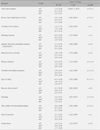Abstract
Purpose
This study was done to explore life stress and coping skills of boarding high school students.
Methods
Triangulation (quantitative and qualitative) research method was used through three stages. First, 47 high school students were interviewed to identify life stressors. Second, 208 students were surveyed via internet questionnaires to assess stress level for each stressor. Lastly, in order to survey stress coping skills, 61 students answered 10 subjective questions orally or in writing.
Results
Thirty-seven life stressors in five categories were identified through thematic content analysis of the interviews: dormitory life, appearance and self management, human relations, study, and other areas. Stresses from schoolwork were highest and participants also experienced stress from their dormitory life. The overall stress level was higher in girls than in boys, and students in their 2nd year perceived their stress as higher than those in other grades. Various stress coping skills were being used, and positive coping skills were commonly used.
Figures and Tables
References
1. Hankookilbo. Diversification of the college entrance examination. 2009. September 6, 2010. fromhttp://news.hankooki.com/lpage/society/200904/h2009040803013322020.htm.
2. Hwang Y. The determinants of perceived academic stress as experienced by high school students. Stud Korean Youth. 2008; 19(3):85–114.
3. Jeon M, Lim S. A relationship between Learned helplessness and stress coping strategy in vocational high school students. Korean Inst Ind Educ. 2010; 35(1):1–19.
4. Kim H, Choi Y, Yoo S. The study on the relations among ego-identity, stress, and internet addiction in high school students. J Korean Acad Psychiatr Ment Health Nurs. 2010; 19:173–185.

5. Kim I. Study on women's sleep disorder and depression. Seoul: Ewha Womans University;2001. Unpublished master's thesis.
6. Kim M, Hong K, Yang S. High school students' stress and their coping styles. Korean J Youth Couns. 2002; 10(1):107–125.
7. Kim S, Ha E. The mediating effects of somato-sensory amplification and somatic attribution on the relationship between adolescent's stress and somatization. J Korean Assoc Play Ther. 2009; 12(2):149–162.
8. Kim S. The effects of daily stress on psychosocial adjustment of Korean high school students: Moderating effects of protective factors. Korean J Youth Stud. 2008; 15:381–406.
9. Kim S. The effects of psychosocial predictors during middle school and high school on adolescent drinking and smoking. J Inst Soc Sci. 2010; 21(3):31–57.

10. Ko H, Chong Y, Min H. The daily stressors and coping strategies in high school students. Home Econ Res. 1999; 2:21–37.
11. Kukminilbo. Boost happiness of future generation. 2009. September 6, 2010. fromhttp://news2.kukinews.com/article/view.asp?page=1&gCode=kmi&arcid=0921283649&cp=du.
12. Kyunghyang. The lowest level of happiness of children and adolescents among OECD nations. 2010. September 6, 2010. fromhttp://news.khan.co.kr/kh_news/khan_art_view.html?artid=201005042304315&code=990101.
13. Lee H, Hyun O. The level of stress and coping behavior of middle and high school students in Korea. J Korean Home Econ Educ. 1996; 8(1):59–78.
14. Lee J. Study on the stress and fatigue symptoms of high school students according to the life styles. Daejeon: Chungnam National University;2003. Unpublished master's thesis.
15. Lee S, Je M. The factors related to stress among high school students. J Korean Soc Matern Child Health. 2008; 11(3):47–58.
16. Moon K. The effect of academic stress on suicidal impulse in adolescence: Mediating roles of parent and peer attachment. Korean Assoc Child Stud. 2006; 27(5):143–157.
17. Park S. Consensual qualitative research on the adaptation of alternative high school students to dormitory lives. Gongju: Kongju National University;2010. Unpublished master's thesis.
18. Patton MQ. Qualitative research & evaluation methods. 3rd ed.California: SAGE;2002.
19. Seo JY. The effects of aromatherapy on stress and stress responses in adolescents. J Korean Acad Nurs. 2009; 39:357–365.

20. Seo JY, Kim M. Stress, physical symptoms, and coping styles of high school students. J Korean Acad Child Health Nurs. 2006; 12:470–477.
21. Wie H. A study on the factors affecting the stress for adolescents. J Korean Acad Psychiatr Ment Health Nurs. 2005; 14:129–138.
22. Woo C. The structural relationship among negative human relations, stress, depression and suicidal ideation of adolescents. Daegu: Keimyung University;2009. Unpublished doctoral dissertation.
23. Yang A, Cho H. The analyse correlation between the leaners' stress and academic achievement. J Korean Assoc Learn-Cent Curric Instr. 2009; 9(1):341–358.




 PDF
PDF ePub
ePub Citation
Citation Print
Print







 XML Download
XML Download